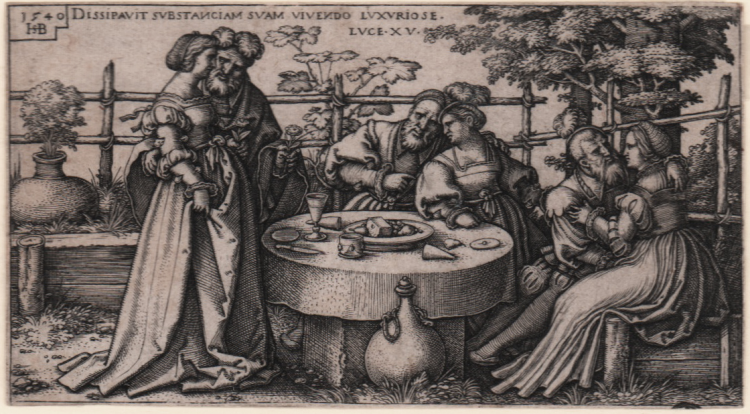



| Reference: | 4109 |
| Author | Hans Sebald BEHAM |
| Year: | 1540 |
| Measures: | 93 x 51 mm |


| Reference: | 4109 |
| Author | Hans Sebald BEHAM |
| Year: | 1540 |
| Measures: | 93 x 51 mm |
Engraving, 1540, signed with monogram and dated on a tablet at upper left. Lettered along upper edge: 'DISSIPAVIT SUBSTANCIAM SUAM VIVENDO LUXORIOSE/ LUCE XV'.
A great impression, printed with tone, on contemporary laid paper, good condition.
The Prodigal Son wasting his fortune; seated at a stone table in a fenced-in garden with two male companions and three courtesans; from a series of four engravings "The Prodigal Son".
Shortly before 1520, several young artists in the immediate circle of Albercht Dürer began making remarkably small engravings that challenged the viewer with a world in miniature; a world of new secular subject and of unconventional interpretations of traditional themes. Because of the scale of their engravings these artists have long been saddled with the unflattering collective name the Little Masters. The core of the group consist in three Nuremberg artists, Hans Sebald & Bartel Beham and Georg Pencz, Jacob Bink form Cologne and Heinrich Aldegrever from Soest.
|
Bartsch VIII.130.32 Pauli 34; Hollstein 34.I
|
Hans Sebald BEHAM Nuremberg 1500 - Frankfurt 1550
|
Engraver, etcher, designer of woodcuts and stained glass, painter and illustrator. In contemporary documents and prints he was nearly always identified as Sebald Beham although since the 17th century (Sandrart) and into the early years of the 20th he has mistakenly been called Hans Sebald Beham on the basis of his monogram: HSP or HSB. This reflects S[ebald] Peham/Beham with the P (Nuremberg pronunciation) changing to B c. 1531, when he appears to have moved to Frankfurt. Sandrart’s biography of him is illustrated with a printed portrait similar to Sebald’s painted Self-portrait in his David panel in the Louvre; around the Sandrart portrait is an inscription identifying him as painter and engraver. Only one of Sebald’s panel paintings has survived (the Story of David, 1534; Paris, Louvre), though documents cited by Hampe and Vogler refer to him as a journeyman for painting in 1521 and as having his own journeyman—i.e. running a workshop—in 1525. Sebald is best known to posterity, however, for his prints, of which he produced a prodigious quantity: approximately 252 engravings, 18 etchings and 1500 woodcuts, including woodcut book illustrations. Biographical information is scanty: Sandrart alleged that he was trained by Barthel and opened a tavern, the bad reputation of which derived from his own dissolute life. Unquestionably, however, he was industrious and meticulous artistically. He began producing prints in quantity in 1519, though a few date to before then: a woodcut of Lust from a series of the Ten Commandments—a youthfully naive work produced in 1512 when Sebald was 12—and a sheet of sometimes awkwardly drawn pen-and-ink studies of male and female heads on red prepared paper (1518; Brunswick, Herzog Anton Ulrich-Mus.). His first engraving, dated 1518, is a diminutive Portrait of a Young Woman.
|
|
Bartsch VIII.130.32 Pauli 34; Hollstein 34.I
|
Hans Sebald BEHAM Nuremberg 1500 - Frankfurt 1550
|
Engraver, etcher, designer of woodcuts and stained glass, painter and illustrator. In contemporary documents and prints he was nearly always identified as Sebald Beham although since the 17th century (Sandrart) and into the early years of the 20th he has mistakenly been called Hans Sebald Beham on the basis of his monogram: HSP or HSB. This reflects S[ebald] Peham/Beham with the P (Nuremberg pronunciation) changing to B c. 1531, when he appears to have moved to Frankfurt. Sandrart’s biography of him is illustrated with a printed portrait similar to Sebald’s painted Self-portrait in his David panel in the Louvre; around the Sandrart portrait is an inscription identifying him as painter and engraver. Only one of Sebald’s panel paintings has survived (the Story of David, 1534; Paris, Louvre), though documents cited by Hampe and Vogler refer to him as a journeyman for painting in 1521 and as having his own journeyman—i.e. running a workshop—in 1525. Sebald is best known to posterity, however, for his prints, of which he produced a prodigious quantity: approximately 252 engravings, 18 etchings and 1500 woodcuts, including woodcut book illustrations. Biographical information is scanty: Sandrart alleged that he was trained by Barthel and opened a tavern, the bad reputation of which derived from his own dissolute life. Unquestionably, however, he was industrious and meticulous artistically. He began producing prints in quantity in 1519, though a few date to before then: a woodcut of Lust from a series of the Ten Commandments—a youthfully naive work produced in 1512 when Sebald was 12—and a sheet of sometimes awkwardly drawn pen-and-ink studies of male and female heads on red prepared paper (1518; Brunswick, Herzog Anton Ulrich-Mus.). His first engraving, dated 1518, is a diminutive Portrait of a Young Woman.
|